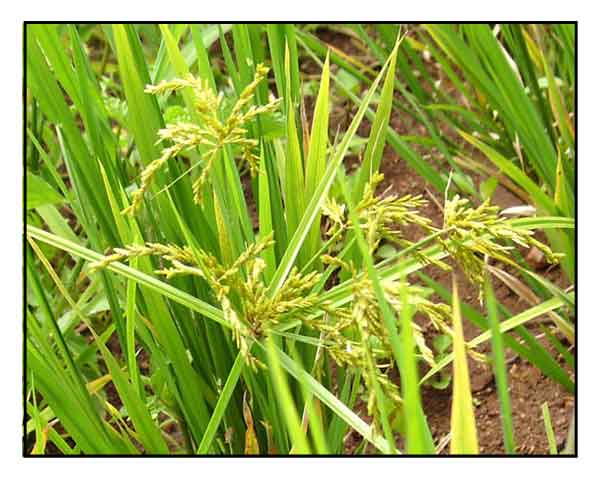|
 Gen info Gen info
- Cyperus is a large genus of about 700 species of sedges, distributed throughout all continents in both tropical and temperate regions.
-
Cyperus iria is a smooth, tufted sedge found worldwide. It often grows in rice paddies, where it is considered a weed.
 Botany Botany
Alinang is a tufted, glabrous annual herb, occasionally perennial, growing
to a height of 10 to 70 centimeters. Roots are fibrous, 15 to 75. Stems are sharply 3-angled, tufted, smooth, 5 to 80 centimeters high. Leaves are short and long, 2 to 5 millimeters wide; sheath, reddish or purplish brown, enveloping the stem at the base. Umbels are 3 to 30 centimeters in diameter, the rays long and short,
few to many. Spikes are loosely spicate. Spikelets are numerous,
yellow or brown, 3 to 10 millimeters long. Glumes are 6 to 20, obovate,
hardly imbricate, about 1.2 millimeters long, 3- to 5-angled, oblong ovoid.
Distribution
- Native to the Philippines.
-
A very common paddy weed in
open, wet places.
- A troublesome weed in ricefields.
- Also found in China, Japan and Korea. In South East Asia: Bangladesh, Cambodia, India, Indonesia, Laos, Malaysia, Myanmar, Nepal, Pakistan, Sri Lanka, Thailand and Vietnam. Also in Australia, Fiji, Swaziland, and West Africa. (3)
Constituents
- Study of aqueous-ethanol extract of C. iria revealed high phenolic and flavonoid contents, 82.79 ± 0.003 mg/g GAE and 13.61 ± 0.002 mg/g QE, respectively. HPLC confirmed the presence of myricetin, quercetin, kaempferol and ferullic acid. (see study below) (9)
Properties
- Tonic, stimulant, stomachic and astringent.
- Study has shown larvicidal, mosquitocidal, antioxidant, antibacterial, antifungal, antidiabetic properties.
Parts
utilized
Tubers, leaves.
Uses
Folkloric
- Decoction of ground tubers used for fevers.
- Among the Mundas
of Chota Nagpur, tuber is ground together with Cyperus
rotundus and taken for fever.
- In India, plant is considered
tonic, stimulant, stomachic and astringent. Used for amenorrhea.
- In
Vietnam, whole plant used for rheumatism, to regulate menstruation. Rhizomes used as diuretic. (7)
Others
- Crafts: Used for weaving mats.
- Fodder: In Vietnam, sometimes used as fodder. (7)
S tudies tudies
• Larvicidal / Mosquito
Control / Leaves: Study of leaves of six Cyperus species of varying
ages were tested on the larvae of yellow fever mosquito. Only Cyperus
iria was found to have significant levels of JH III (juvenile hormone
III) and suggests a potential for a safe, inexpensive and readily available
mosquito larvicidal for the yellow fever mosquito Aedes aegypti. (1)
• Antioxidant: Study of wetland medicinal plants for antioxidant capacities in the TEAC assay ranged from 7.53 µM to 1753.41 µM Trolox/mg water extract and 5.69 µM to 2074.35 µM Trolox/mg for methanol extracts. C. iria water extract showed 762.94 ±33.80 µM Trolox/mg while the methanol extract showed 769.41 ±53.57 µM Trolox/mg. Study also reports on reducing capacity value, DPPH assay, and total polyphenol contents. (6)
• Terpenoids / Antifungal / Leaves: Ricefield flatsedge is a troublesome weed in rice production. Study identified terpenoids as dominant compounds from organic extracts of C. iria leaves, and evaluated the role of terpenoid production in plant development and resistance to abiotic and biotic stresses. During vegetative growth, total concentration of sesquiterpenoids increased and reached maximum 70 days after germination, then decreased until the emergence of inflorescence. Monoterpenoids were detected from leaves only 90 days after germination. Infestation by beet armyworm (Spodoptera exigua) promoted the emission of total sesquiterpenoids and induced production of more monoterpenoids and sesquiterpenoids. Authors discussed the implications of findings on biosynthetic pathways of sesquiterpenoid production and their potential as fungicides. (8)
• Antidiabetic / Anti-Inflammatory / Whole Plant: Study evaluated aqueous-ethanol extract of air-dried whole plant of Cyperus iria for invitro and invivo antihyperglycemmic activity and effects on oxidative stress, and inflammatory cytokines in rats. Extract showed excellent potential for both antioxidant (IC50 3.22 µg/mL) and alpha-amylase (IC50 32.29 µg/mL) inhibitory assays. Streptozotocin induced hyperglycemia declined with improvement in inflammatory and oxidative stress markers along with biochemical parameters in a dose-dependent manner. The hypoglycemic potential may be attributed to the presence of phenolics and flavonoids. (see constituents above) (9)
• Antimicrobial / Aerial and Underground Parts: In a study for antimicrobial activity, the chloroform phase of C. iria showed best results at concentration of only 31.2 µg/mL against pathogens Candida albicans and Staphylococcus aureus. (10)
Availability
Wild-crafted.
|


![]()

